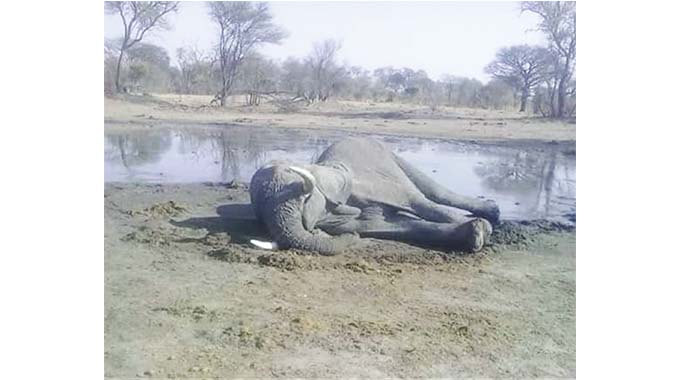
Leonard Ncube, Victoria Falls Reporter
ELEVEN elephants have been found dead in Pandamasue Forest outside Hwange National Park towards the border with Botswana.
The deaths come as neighbouring Botswana recorded nearly 400 elephants deaths since May in eastern Okavango, Seronga and Delta areas.
There are fears the extensive west to east wildlife migrations that usually take place between the two countries during the dry season as observed through elephant collaring, could spread the diseases that have been killing jumbos in Botswana.
Zimbabwe Parks and Wildlife Management Authority (Zimparks) spokesperson Mr Tinashe Farawo said preliminary investigations have ruled out poaching and cyanide poisoning, usually prevalent around Hwange National Park.

Mr Tinashe Farawo
He said Zimparks suspects that the jumbos could have died of anthrax and a team of veterinary doctors were on the ground investigating.
The carcasses were discovered on Friday and the tasks were intact.
“We can confirm that 11 elephants have been found dead and we’re investigating the cause of the death. Our preliminary investigations have ruled out poaching and cyanide poisoning because the tasks are intact and no other animal species has been affected including vultures,” said Mr Farawo. “Zimparks suspects anthrax and veterinary doctors are on the ground. We have taken samples to the laboratory and we are waiting for results. The affected animals are sub-adults and calves and they all died within the proximity of water bodies.”.
Pandamasue Forest is located between Hwange and Victoria Falls towards the border with Botswana.
Mr Farawo said they will be guided by laboratory test results on the possible cause of the deaths.
He said investigations will also likely establish if the deaths are linked to the Botswana ones.
Wildlife conservationist Mr Trevor Lane of Bhejane Trust said as private wildlife experts, they were also carrying out investigations.
Last year some elephants, buffaloes and other wildlife species died from suspected anthrax in the Zambezi Valley, a year after 20 hippos died in Mlibizi area, Binga from the same disease.
About 200 elephants also died at Hwange National Park between September and November last year due to drought that resulted in shortage of food and water.
According to Zimparks, elephant calves were the hardest hit by the adverse effects and soaring temperatures as they are highly sensitive to heat, are unable to reach tree branches, dig up roots and uproot trees for food.
The elephant population in Hwange National Park is between 45 000 and 53 000 against a carrying capacity of 15 000.
Zimparks says overpopulation is contributing to escalating human-wildlife conflicts as animals stray into human settlements in search of food and water.
Elephants are voracious feeders, with each eating about 272kg of grass and leaves and drinking 200 litres of water per day.
Mr Farawo said Zimparks needs investors and partnerships to save wildlife. Zimparks supplements water using solar and diesel powered engines and some windmill pumps during the dry season.
Meanwhile, Botswana authorities are still grappling with the mysterious deaths after samples that were sent to laboratories in Zimbabwe and South Africa proved inconclusive. Pesticides, agrochemicals and pathogens were ruled out, according to press reports in Botswana, where the deaths have been described by wildlife experts as a conservation disaster.
Botswana has the biggest elephants population in Southern Africa with more than 130 000 jumbos. — @ncubeleon
